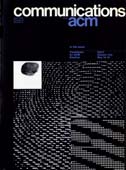April 1972 - Vol. 15 No. 4

Features
On the implementation of security measures in information systems
A system for interprocess communication in a resource sharing computer network
An experimental laboratory for pattern recognition and signal processing
Hidden lines elimination for a rotating object
An implemented graph algorithm for winning Shannon Switching Games
Computers and society: a proposed course for computer scientists
Complex gamma function with error control
Matrix computations with Fortran and paging
Algorithm 421: complex gamma function with error control [S14]
Algorithm 422: minimal spanning tree [H]
A note on Cheney’s nonrecursive list-compacting algorithm
A comment on the double-chained tree



